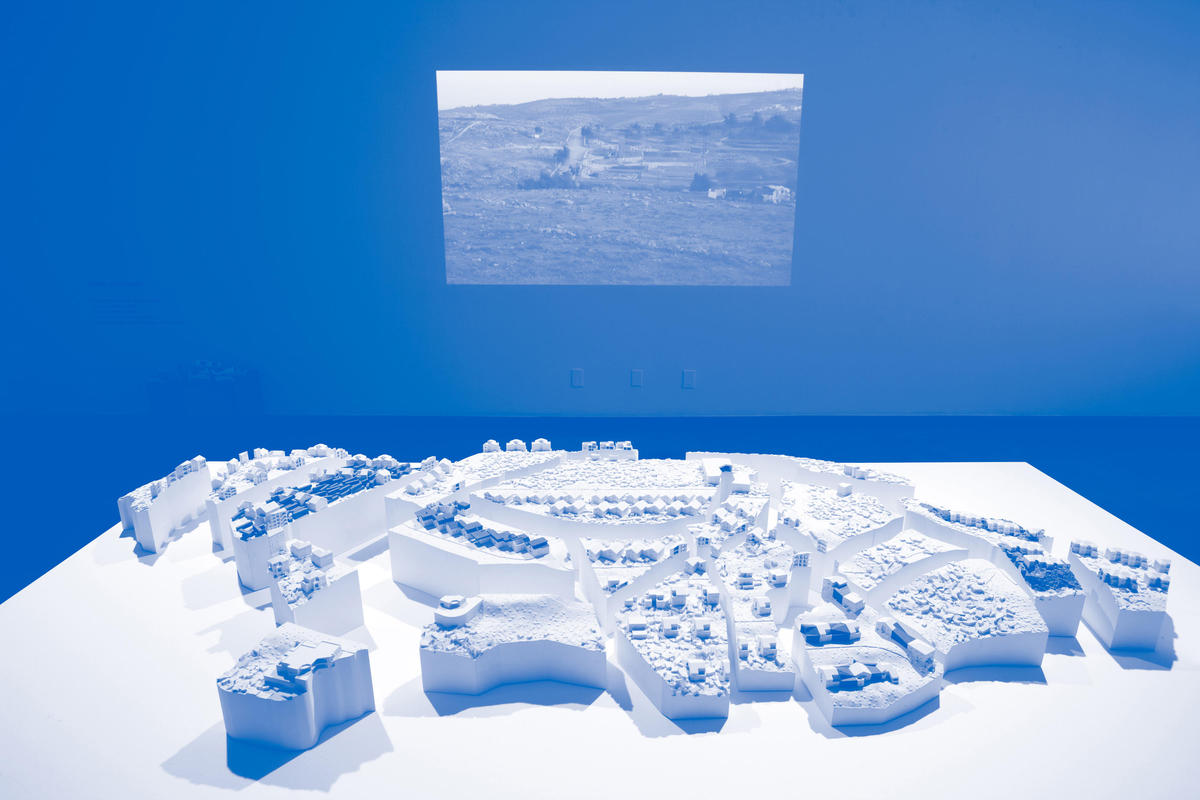
Los Angeles
Decolonizing Architecture
REDCAT
December 7, 2010–February 6, 2011
In August, 1993, a red line was drawn on a map of the West Bank, dividing it into three zones: one in Israeli hands, one under Palestinian control, and one under shared (Israeli military and Palestinian civilian) supervision, in an arrangement known as the Oslo Accords. In ‘Decolonizing Architecture,’ a recent exhibition project at REDCAT, this thread of a line is spatialized, transformed into a five-and-a-half-meter stripe, and projected deep into a series of photographic landscapes. Rescaled at 1:20,000, red ink razors across empty territory and through dividing walls, bleeding indiscriminately into the real space of local communities. The width of the line is presented as an undefined, extraterritorial space where prevailing legal contingencies are void and indeterminate possibilities open up. Titled The Red Castle and the Lawless Line (after a newly built castle that falls in its trajectory), the project is one of a trio that make up this exhibition, where territorial surveys, research reports, architectural plans, photographs, and architectural models provide a site for politics and poetics to converge.
Founded in 2007, DAAR (Decolonizing Architecture Art Residency) focuses on Palestine as a prism through which to view larger issues of architecture and decolonization in general. The REDCAT exhibit marks the first time that the Bethlehem-based DAAR has shown in the US, and though the exhibition bears the names of Alessandro Petti, Sandi Hilal, and Eyal Weizman, the group cites a range of other resident-collaborators. At his opening talk, Weizman framed DAAR’s activities as a search for a “third way” to inhabit defunct colonial infrastructures — an approach that would neither resort to pure destruction nor continue to trace the well-worn paths of colonial use once power had shifted.
In How to Inhabit Your Enemy’s House, for example, the collective confronts the deserted Israeli settlements left behind in Gaza and the West Bank from 2005 onward, model suburbs turned post-apocalyptic when they were forcibly emptied out on short notice. Their main proposition is visualized in the literal superimposition of pre-settlement landownership maps over the existing suburban fabric, dual projections printed in a row of glossy research publications (with white gloves to turn white pages), and accompanied by two short videos (one 3-D) and an architectural model. The premise is straightforward: voided domestic spaces might host new public services, including hospitals and schools, in an area where these were previously unable to develop. The literal act of superimposition from above, the discussion of “returning public property to the public,” and a palpable phobia of suburban models in general, seemed perplexingly basic, even dogmatic, in the wake of Weizman’s eloquent explanation of the far-from-basic circumstances in which DAAR functions. Is there something more to be gained by recalling the variegated histories of these structures themselves, established for an array of reasons — in some cases, with rabidly ideological intent, in others, because of a literal lack of space in the region? What remains disappointingly unaltered in How to Inhabit Your Enemy’s House is a vision of these sites as an abstracted territory from which we remain at a comfortable remove — something that the other two portions of the exhibit more successfully move beyond.
Shifting registers, the project Return to Nature features a series of photographs, projected alterations for a deserted military base in Oush Grab. In what Weizman memorably described as a “Hitchcockian nightmare,” the unused site has been taken over by migratory birds. Photographs of the project, which is being conducted in cooperation with the Palestinian Wildlife Association, show cement walls encouraged to crumble via a regular grid of perfectly round holes drilled across their surface. What do you do with a military ghost town filled with sepulchral black birds? It’s hard to argue against the addition of a minimalist grid to enhance a process of guided ruination in the face of such surreal circumstances.
In 1995, Francis Alÿs staged The Leak, an embodied reinterpretation of Moshe Dayan’s iconic 1948 gesture of tracing a green line across a map to mark the armistice boundary at the end of Israel’s War of Independence. Alÿs followed the same border on foot, trailing a thin, wobbly stream of green paint behind him, pushing Dayan’s historic act of line-drawing to the brink of the absurd. Like Alÿs, the altered digital photographs in The Red Castle and the Lawless Line follow the impulse to shift an abstract cartographic gesture to a new site, in an effort to provoke alternative interpretations by engaging with its implications on the ground. But what may initially appear as catchy theorizations on a gallery wall are, in DAAR’s projects, embedded in a range of physical and institutional sites whose very distance from the gallery context is not always a comfortable one.
According to Weizman, DAAR hopes to translate the thickness of the red Oslo Accords into legislation; the Palestinian Wildlife Association will ostensibly be funding some kind of undertaking at Oush Grab. And when Weizman spoke of the unique power of the architectural model to focus a roomful of people on “transcending their ideological blocks,” one couldn’t help but wonder if this happened at meetings held to discuss the fate of the Israeli settlements, where both Weizman and Condoleeza Rice were present. Because this is first and foremost an architectural project, the concrete (political boundaries, historical facts) and the projected (ideas for the future, into a specific space) carry rather a different valence than they might in works (like Alÿs’) that we are a bit more accustomed to seeing in the art gallery context. The architectural collective emphasizes that their practice is a perpetual process; that it is not solution-oriented; that it is “not design, but an arena of speculation” devoted to “future scenarios for Palestine.” Nevertheless, REDCAT debut ‘Decolonizing Architecture’ never makes it entirely clear: where do “speculation” and “execution” begin and end?